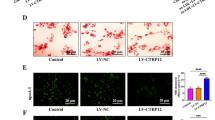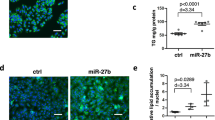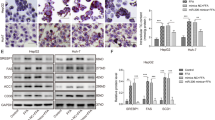Abstract
Hyperlipidemia is a risk factor for various cardiovascular and metabolic disorders. Overproduction of lipoproteins, a process that is dependent on microsomal triglyceride transfer protein (MTP), can contribute to hyperlipidemia. We show that microRNA-30c (miR-30c) interacts with the 3′ untranslated region of MTP mRNA and induces its degradation, leading to reductions in MTP activity and in apolipoprotein B (APOB) secretion. miR-30c also reduces lipid synthesis independently of MTP. Hepatic overexpression of miR-30c reduced hyperlipidemia in Western diet–fed mice by decreasing lipid synthesis and the secretion of triglyceride-rich ApoB-containing lipoproteins and decreased atherosclerosis in Apoe−/− mice. Furthermore, inhibition of hepatic miR-30c by anti–miR-30c increased hyperlipidemia and atherosclerosis. Therefore, miR-30c coordinately reduces lipid biosynthesis and lipoprotein secretion, thereby regulating hepatic and plasma lipid concentrations. Raising miR-30c levels might be useful in treating hyperlipidemias and associated disorders.
This is a preview of subscription content, access via your institution
Access options
Subscribe to this journal
Receive 12 print issues and online access
$209.00 per year
only $17.42 per issue
Buy this article
- Purchase on Springer Link
- Instant access to full article PDF
Prices may be subject to local taxes which are calculated during checkout






Similar content being viewed by others
Change history
20 September 2013
In the version of this article initially published, the text incorrectly described the results of previously published studies of miR-30 family members. This sentence has now been corrected to read as follows: “miR-30a has a role in Xenopus kidney development26, miR-30e regulates apoptosis in breast tumor cells27, and miR-30a, miR-30c and miR-30d stimulate adipogenesis28,29.” The error has been corrected for the PDF and HTML versions of this article.
References
Heidenreich, P.A. et al. Forecasting the future of cardiovascular disease in the United States: a policy statement from the American Heart Association. Circulation 123, 933–944 (2011).
Grundy, S.M. et al. Implications of recent clinical trials for the National Cholesterol Education Program Adult Treatment Panel III guidelines. Circulation 110, 227–239 (2004).
Hussain, M.M. & Pan, X. Clock genes, intestinal transport and plasma lipid homeostasis. Trends Endocrinol. Metab. 20, 177–185 (2009).
Hussain, M.M., Fatma, S., Pan, X. & Iqbal, J. Intestinal lipoprotein assembly. Curr. Opin. Lipidol. 16, 281–285 (2005).
Hussain, M.M. et al. Microsomal triglyceride transfer protein in plasma and cellular lipid metabolism. Curr. Opin. Lipidol. 19, 277–284 (2008).
Hussain, M.M., Shi, J. & Dreizen, P. Microsomal triglyceride transfer protein and its role in apolipoprotein B–lipoprotein assembly. J. Lipid Res. 44, 22–32 (2003).
Hussain, M.M., Rava, P., Walsh, M., Rana, M. & Iqbal, J. Multiple functions of microsomal triglyceride transfer protein. Nutr. Metab. (Lond) 9, 14 (2012).
Berriot-Varoqueaux, N., Aggerbeck, L.P., Samson-Bouma, M. & Wetterau, J.R. The role of the microsomal triglygeride transfer protein in abetalipoproteinemia. Annu. Rev. Nutr. 20, 663–697 (2000).
Burnett, J.R. & Watts, G.F. MTP inhibition as a treatment for dyslipidaemias: time to deliver or empty promises? Expert Opin. Ther. Targets 11, 181–189 (2007).
Hussain, M.M. & Bakillah, A. New approaches to target microsomal triglyceride transfer protein. Curr. Opin. Lipidol. 19, 572–578 (2008).
Cuchel, M. et al. Inhibition of microsomal triglyceride transfer protein in familial hypercholesterolemia. N. Engl. J. Med. 356, 148–156 (2007).
Samaha, F.F., McKenney, J., Bloedon, L.T., Sasiela, W.J. & Rader, D.J. Inhibition of microsomal triglyceride transfer protein alone or with ezetimibe in patients with moderate hypercholesterolemia. Nat. Clin. Pract. Cardiovasc. Med. 5, 497–505 (2008).
Bartel, D.P. MicroRNAs: genomics, biogenesis, mechanism, and function. Cell 116, 281–297 (2004).
Bartel, D.P. MicroRNAs: target recognition and regulatory functions. Cell 136, 215–233 (2009).
Berezikov, E. Evolution of microRNA diversity and regulation in animals. Nat. Rev. Genet. 12, 846–860 (2011).
Millar, J.S., Cromley, D.A., McCoy, M.G., Rader, D.J. & Billheimer, J.T. Determining hepatic triglyceride production in mice: comparison of poloxamer 407 with Triton WR-1339. J. Lipid Res. 46, 2023–2028 (2005).
Trajkovski, M. et al. MicroRNAs 103 and 107 regulate insulin sensitivity. Nature 474, 649–653 (2011).
Vickers, K.C. et al. MicroRNA-27b is a regulatory hub in lipid metabolism and is altered in dyslipidemia. Hepatology 57, 533–542 (2013).
Rayner, K.J. et al. MiR-33 contributes to the regulation of cholesterol homeostasis. Science 328, 1570–1573 (2010).
Najafi-Shoushtari, S.H. et al. MicroRNA-33 and the SREBP host genes cooperate to control cholesterol homeostasis. Science 328, 1566–1569 (2010).
Marquart, T.J., Allen, R.M., Ory, D.S. & Baldan, A. miR-33 links SREBP-2 induction to repression of sterol transporters. Proc. Natl. Acad. Sci. USA 107, 12228–12232 (2010).
Zsigmond, E., Fuke, Y., Li, L., Kobayashi, K. & Chan, L. Resistance of chylomicron and VLDL remnants to post-heparin lipolysis in ApoE-deficient mice: the role of apoE in lipoprotein lipase-mediated lipolysis in vivo and in vitro. J. Lipid Res. 39, 1852–1861 (1998).
Westerterp, M., de Haan, W., Berbee, J.F., Havekes, L.M. & Rensen, P.C. Endogenous apoC-I increases hyperlipidemia in apoE-knockout mice by stimulating VLDL production and inhibiting LPL. J. Lipid Res. 47, 1203–1211 (2006).
Lagos-Quintana, M., Rauhut, R., Lendeckel, W. & Tuschl, T. Identification of novel genes coding for small expressed RNAs. Science 294, 853–858 (2001).
Lagos-Quintana, M. et al. Identification of tissue-specific microRNAs from mouse. Curr. Biol. 12, 735–739 (2002).
Agrawal, R., Tran, U. & Wessely, O. The miR-30 miRNA family regulates Xenopus pronephros development and targets the transcription factor Xlim1/Lhx1. Development 136, 3927–3936 (2009).
Yu, F. et al. Mir-30 reduction maintains self-renewal and inhibits apoptosis in breast tumor-initiating cells. Oncogene 29, 4194–4204 (2010).
Zaragosi, L.E. et al. Small RNA sequencing reveals miR-642a-3p as a novel adipocyte-specific microRNA and miR-30 as a key regulator of human adipogenesis. Genome Biol. 12, R64 (2011).
Karbiener, M. et al. MicroRNA-30c promotes human adipocyte differentiation and co-represses PAI-1 and ALK2. RNA Biol. 8, 850–860 (2011).
Chang, B.H.J. et al. Liver-specific inactivation of the abetalipoproteinemia gene completely abrogates very low density lipoprotein low density lipoprotein production in a viable conditional knockout mouse. J. Biol. Chem. 274, 6051–6055 (1999).
Khatun, I. et al. Phospholipid transfer activity of MTP promotes assembly of phospholipid-rich apoB-containing lipoproteins and reduces plasma as well as hepatic lipids in mice. Hepatology 55, 1356–1368 (2012).
Iqbal, J., Anwar, K. & Hussain, M.M. Multiple, independently regulated pathways of cholesterol transport across the intestinal epithelial cells. J. Biol. Chem. 278, 31610–31620 (2003).
Ibrahimi, A. et al. Muscle-specific overexpression of FAT/CD36 enhances fatty acid oxidation by contracting muscle, reduces plasma triglycerides and fatty acids, and increases plasma glucose and insulin. J. Biol. Chem. 274, 26761–26766 (1999).
Wu, X., Zhou, M.Y., Huang, L.S., Wetterau, J. & Ginsberg, H.N. Demonstration of a physical interaction between microsomal triglyceride transfer protein and apolipoprotein B during the assembly of ApoB-containing lipoproteins. J. Biol. Chem. 271, 10277–10281 (1996).
Athar, H., Iqbal, J., Jiang, X.C. & Hussain, M.M. A simple, rapid, and sensitive fluorescence assay for microsomal triglyceride transfer protein. J. Lipid Res. 45, 764–772 (2004).
Rava, P., Athar, H., Johnson, C. & Hussain, M.M. Transfer of cholesteryl esters and phospholipids as well as net deposition by microsomal triglyceride transfer protein. J. Lipid Res. 46, 1779–1785 (2005).
Jamil, H. et al. An inhibitor of the microsomal triglyceride transfer protein inhibits apoB secretion from HepG2 cells. Proc. Natl. Acad. Sci. USA 93, 11991–11995 (1996).
Sellers, J.A., Hou, L., Athar, H., Hussain, M.M. & Shelness, G.S. A Drosophila microsomal triglyceride transfer protein homolog promotes the assembly and secretion of human apolipoprotein B: implications for human and insect lipid transport and metabolism. J. Biol. Chem. 278, 20367–20373 (2003).
Dai, K., Khatun, I. & Hussain, M.M. NR2F1 and IRE1-β suppress microsomal triglyceride transfer protein expression and lipoprotein assembly in undifferentiated intestinal epithelial cells. Arterioscler. Thromb. Vasc. Biol. 30, 568–574 (2010).
Folch, J., Lees, M. & Sloane Stanley, G.H. A simple method for the isolation and purification of total lipides from animal tissues. J. Biol. Chem. 226, 497–509 (1957).
Stansbie, D., Brownsey, R.W., Crettaz, M. & Denton, R.M. Acute effects in vivo of anti-insulin serum on rates of fatty acid synthesis and activities of acetyl-coenzyme A carboxylase and pyruvate dehydrogenase in liver and epididymal adipose tissue of fed rats. Biochem. J. 160, 413–416 (1976).
Iritani, N., Yamashita, S. & Numa, S. Dietary control of triglyceride and phospholipid synthesis in rat liver slices. J. Biochem. 80, 217–222 (1976).
Iqbal, J. et al. Increased intestinal lipid absorption caused by Ire1β deficiency contributes to hyperlipidemia and atherosclerosis in apolipoprotein E–deficient mice. Circ. Res. 110, 1575–1584 (2012).
Acknowledgements
This work was supported in part by US National Institutes of Health grants DK-46900 and HL-95924 to M.M.H. Mttpflox/flox mice were from L. Chan (Baylor University).
Author information
Authors and Affiliations
Contributions
J.S. performed all the experiments, analyzed data and wrote a draft of the paper. J.I. taught J.S. different techniques, participated in atherosclerosis experiments and edited figures. J.Q. performed sectioning and staining of aortas. C.F.-H. discussed experiments and edited the manuscript. M.M.H. conceived the ideas, designed and discussed experiments, supervised progress and extensively edited and communicated regarding the manuscript.
Corresponding author
Ethics declarations
Competing interests
The authors declare no competing financial interests.
Supplementary information
Supplementary Text and Figures
Supplementary Table 1 and Supplementary Figures 1–9 (PDF 1468 kb)
Rights and permissions
About this article
Cite this article
Soh, J., Iqbal, J., Queiroz, J. et al. MicroRNA-30c reduces hyperlipidemia and atherosclerosis in mice by decreasing lipid synthesis and lipoprotein secretion. Nat Med 19, 892–900 (2013). https://doi.org/10.1038/nm.3200
Received:
Accepted:
Published:
Issue Date:
DOI: https://doi.org/10.1038/nm.3200
This article is cited by
-
MicroRNAs and Cardiovascular Disease Risk
Current Cardiology Reports (2024)
-
Effect of miR-149-5p on intramuscular fat deposition in pigs based on metabolomics and transcriptomics
BMC Genomics (2023)
-
The roles of different microRNAs in the regulation of cholesterol in viral hepatitis
Cell Communication and Signaling (2023)
-
In silico and in vitro analysis of microRNAs with therapeutic potential in atherosclerosis
Scientific Reports (2022)
-
MiR-30c-1-3p targets matrix metalloproteinase 9 involved in the rupture of abdominal aortic aneurysms
Journal of Molecular Medicine (2022)



